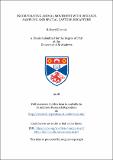Files in this item
Incorporating animal movement with distance sampling and spatial capture-recapture
Item metadata
| dc.contributor.advisor | Buckland, S. T. (Stephen T.) | |
| dc.contributor.advisor | Langrock, Roland | |
| dc.contributor.author | Glennie, Richard | |
| dc.coverage.spatial | x, 258 p. | en_US |
| dc.date.accessioned | 2018-11-15T08:58:52Z | |
| dc.date.available | 2018-11-15T08:58:52Z | |
| dc.date.issued | 2018-12-06 | |
| dc.identifier.uri | https://hdl.handle.net/10023/16467 | |
| dc.description.abstract | Distance sampling and spatial capture-recapture are statistical methods to estimate the number of animals in a wild population based on encounters between these animals and scientific detectors. Both methods estimate the probability an animal is detected during a survey, but do not explicitly model animal movement. The primary challenge is that animal movement in these surveys is unobserved; one must average over all possible paths each animal could have travelled during the survey. In this thesis, a general statistical model, with distance sampling and spatial capture-recapture as special cases, is presented that explicitly incorporates animal movement. An efficient algorithm to integrate over all possible movement paths, based on quadrature and hidden Markov modelling, is given to overcome the computational obstacles. For distance sampling, simulation studies and case studies show that incorporating animal movement can reduce the bias in estimated abundance found in conventional models and expand application of distance sampling to surveys that violate the assumption of no animal movement. For spatial capture-recapture, continuous-time encounter records are used to make detailed inference on where animals spend their time during the survey. In surveys conducted in discrete occasions, maximum likelihood models that allow for mobile activity centres are presented to account for transience, dispersal, and heterogeneous space use. These methods provide an alternative when animal movement causes bias in standard methods and the opportunity to gain richer inference on how animals move, where they spend their time, and how they interact. | en_US |
| dc.language.iso | en | en_US |
| dc.publisher | University of St Andrews | |
| dc.subject | Distance sampling | en_US |
| dc.subject | Capture recapture | en_US |
| dc.subject | Animal movement | en_US |
| dc.subject | Hidden Markov model | en_US |
| dc.subject | Continuous time models | en_US |
| dc.subject | Encounter models | en_US |
| dc.subject | Path integration | en_US |
| dc.subject.lcc | QL751.65S73G6 | |
| dc.subject.lcsh | Animal behaviour--Statistical methods | en |
| dc.subject.lcsh | Sampling (Statistics) | en |
| dc.subject.lcsh | Animal locomotion | en |
| dc.title | Incorporating animal movement with distance sampling and spatial capture-recapture | en_US |
| dc.type | Thesis | en_US |
| dc.contributor.sponsor | Carnegie Trust for the Universities of Scotland | en_US |
| dc.type.qualificationlevel | Doctoral | en_US |
| dc.type.qualificationname | PhD Doctor of Philosophy | en_US |
| dc.publisher.institution | The University of St Andrews | en_US |
| dc.identifier.doi | https://doi.org/10.17630/10023-16467 |
This item appears in the following Collection(s)
Items in the St Andrews Research Repository are protected by copyright, with all rights reserved, unless otherwise indicated.

